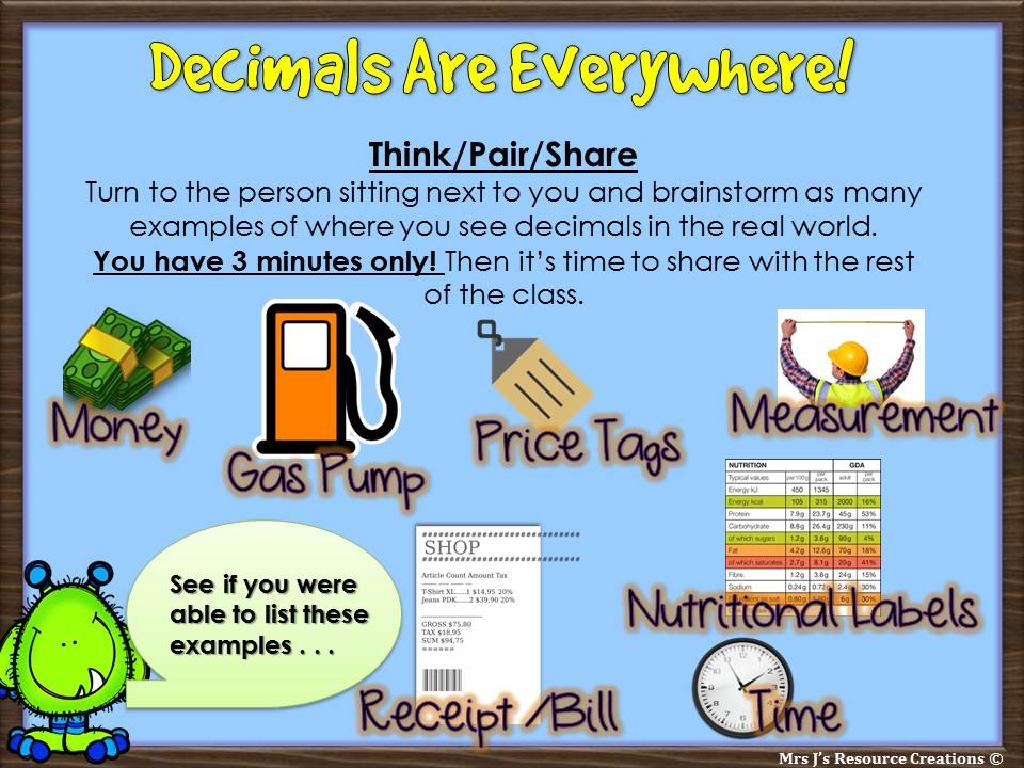Form And Use Plurals Of Nouns Ending In F, Fe, O, And Y
Subject: Language arts
Grade: Fifth grade
Topic: Nouns
Please LOG IN to download the presentation. Access is available to registered users only.
View More Content
Plurals of Nouns: f, fe, o, y
– Singular vs. Plural Nouns
– Singular means one; plural means more than one.
– Plurals: f and fe to ves
– Change f or fe to ves: leaf to leaves, knife to knives.
– Plurals: o to oes or os
– Add es or just s: potato to potatoes, piano to pianos.
– Plurals: y to ies or ys
– Change y to ies or add s: baby to babies, toy to toys.
|
This slide introduces the concept of singular and plural nouns, focusing on the irregular plural forms of nouns ending in f, fe, o, and y. It’s crucial for students to understand that while most nouns simply add an ‘s’ to become plural, some follow different rules. For example, nouns ending in ‘f’ or ‘fe’ often change to ‘ves’ in the plural form. Nouns ending in ‘o’ can add either ‘es’ or ‘s’, depending on the word. And nouns ending in ‘y’ change to ‘ies’ if preceded by a consonant, but just add ‘s’ if preceded by a vowel. Provide examples and have students practice transforming singular nouns into their plural forms. This knowledge will enhance their writing and reading comprehension skills.
Singular and Plural Nouns
– Define Singular Noun
– A singular noun names one person, place, thing, or idea.
– Define Plural Noun
– A plural noun names more than one person, place, thing, or idea.
– Singular to Plural Rules
– Change ‘f’ or ‘fe’ to ‘ves’, add ‘es’ to ‘o’, change ‘y’ to ‘ies’.
– Practice with Examples
– ‘leaf’ to ‘leaves’, ‘hero’ to ‘heroes’, ‘baby’ to ‘babies’.
|
This slide introduces the concept of singular and plural nouns to fifth graders. Begin by explaining that a singular noun refers to one single entity, while a plural noun refers to multiple entities. Emphasize the spelling rules for changing singular nouns ending in ‘f’, ‘fe’, ‘o’, and ‘y’ to their plural forms. Provide clear examples for each rule to ensure understanding. Encourage students to come up with their own examples and write them down for practice. In the next class, review these rules and ask students to share their examples to reinforce learning.
Plural Forms: ‘f’ and ‘fe’ Endings
– Rule: ‘f’ or ‘fe’ to ‘ves’
– For some nouns ending in ‘f’ or ‘fe’, we use ‘ves’ for the plural form.
– Example: ‘leaf’ to ‘leaves’
– A single ‘leaf’ turns into many ‘leaves’.
– Example: ‘knife’ to ‘knives’
– One ‘knife’ changes to a set of ‘knives’.
– Exceptions to the rule
– Not all words follow this rule, like ‘roof’ to ‘roofs’.
|
This slide introduces the concept of forming plurals for nouns ending in ‘f’ or ‘fe’. The general rule is to replace ‘f’ or ‘fe’ with ‘ves’ for the plural form. Use examples like ‘leaf’ and ‘knife’ to illustrate the rule. However, it’s crucial to highlight that there are exceptions. Some words simply add an ‘s’, such as ‘roof’ becoming ‘roofs’. Encourage students to think of more examples and to be aware of the exceptions. Provide a worksheet with a mix of regular and exception words for students to convert into plurals as practice.
Plural Nouns: When ‘o’ Becomes ‘oes’
– Rule: ‘o’ to ‘oes’ for some nouns
– Add ‘es’ to nouns ending in ‘o’ like ‘tomato’ becomes ‘tomatoes’
– Example: ‘potato’ to ‘potatoes’
– ‘Potato’ changes to ‘potatoes’ when it’s more than one
– Example: ‘hero’ to ‘heroes’
– ‘Hero’ changes to ‘heroes’ when talking about many
– When to add just ‘s’
– Some nouns need only ‘s’, like ‘photo’ becomes ‘photos’
|
This slide introduces the rule for forming plurals of nouns ending in ‘o’. In many cases, we add ‘es’ to create the plural form, such as ‘potato’ becoming ‘potatoes’ and ‘hero’ becoming ‘heroes’. However, there are exceptions to this rule where we simply add ‘s’. It’s important to provide students with a clear understanding of when to apply each rule. Encourage students to think of other nouns ending in ‘o’ and decide if they would add ‘es’ or just ‘s’ to make them plural. Provide a list of words for practice and ask students to explain their reasoning for the spelling of each plural noun.
Plural Nouns: When ‘y’ Becomes ‘ies’
– Change ‘y’ to ‘ies’ for plurals
– If a noun ends in a consonant + ‘y’, make it ‘ies’ for plural
– ‘y’ after consonant: add ‘ies’
– For example, ‘city’ ends with ‘t’ + ‘y’, so it becomes ‘cities’
– ‘baby’ to ‘babies’, ‘lady’ to ‘ladies’
– Remember: ‘baby’ turns into ‘babies’ and ‘lady’ turns into ‘ladies’
– When to add just ‘s’
– If ‘y’ follows a vowel, just add ‘s’ like ‘boys’, ‘days’
|
This slide focuses on the rule for forming plurals of nouns ending in ‘y’. When a noun ends in a consonant followed by ‘y’, the ‘y’ is changed to ‘ies’ to make the noun plural. Provide students with examples such as ‘baby’ to ‘babies’ and ‘lady’ to ‘ladies’. It’s crucial to highlight that this rule only applies when a consonant precedes the ‘y’. If a vowel precedes the ‘y’, students simply add an ‘s’ to form the plural. Encourage students to come up with their own examples and write sentences using both singular and plural forms. This will help solidify their understanding of the rule and its application.
Let’s Practice Plural Forms!
– Identify correct plurals: f, fe, o, y
– Change f/fe to ves, o to oes, y to ies
– Create your own plural examples
– Use your favorite nouns ending in f, fe, o, y
– Share your examples with the class
– Discuss with peers and learn from them
– Understand rules for each ending
|
This slide is an interactive class activity designed to reinforce the lesson on forming plurals of nouns ending in f, fe, o, and y. Students will first identify the correct plural forms of given nouns, focusing on the different rules such as changing ‘f’ or ‘fe’ to ‘ves’ (e.g., ‘wolf’ to ‘wolves’), adding ‘es’ to nouns ending in ‘o’ (e.g., ‘potato’ to ‘potatoes’), and changing ‘y’ to ‘ies’ when preceded by a consonant (e.g., ‘puppy’ to ‘puppies’). Afterward, they will create their own examples to solidify their understanding. Encourage students to be creative and come up with unique nouns. Finally, they will share their examples with the class, which will allow them to learn from each other and clarify any misconceptions. The teacher should facilitate the sharing session, provide feedback, and ensure that each student participates. Possible activities include a noun hunt in the classroom, a creative writing task using plural nouns, or a group competition to come up with the most nouns in a given time.
Class Activity: Plural Scavenger Hunt
– Find items ending in f, fe, o, y
– Write singular and plural forms
– Example: leaf, leaves / knife, knives
– Discuss pluralization rules
– Why does ‘leaf’ become ‘leaves’ but ‘roof’ becomes ‘roofs’?
– Group sharing of findings
|
This activity is designed to help students understand the rules of pluralization for nouns ending in f, fe, o, and y. Have the students search the classroom for items that end with these letters, and then write down both the singular and plural forms of these nouns. Encourage them to discuss within their groups why they think certain words change the way they do when made plural. After the activity, bring the class together and have a group sharing session to discuss their findings. Possible variations of the activity could include: 1) Creating a classroom display of the words found, 2) Having students draw the items they found, 3) Creating a classroom dictionary of singular and plural nouns.
Wrapping Up: Plurals and Homework
– Recap of plural noun rules
– Remember: ‘f’ to ‘ves’, ‘y’ to ‘ies’, add ‘s’ or ‘es’
– Homework: 10 sentences with plurals
– Use words ending in f, fe, o, y in new sentences
– Study for the upcoming quiz
– Review today’s lesson to ace the quiz
– Practice makes perfect!
|
As we conclude today’s lesson, remind students of the key rules for forming plurals from nouns ending in f, fe, o, and y. For homework, they should write 10 original sentences using plural nouns that were covered in class, which will help reinforce their understanding. Encourage them to be creative and use a variety of examples. Also, inform them about the upcoming quiz to motivate them to review the lesson material. Provide some study tips, such as making flashcards or practicing with a classmate. Remember to praise their efforts and progress in mastering plurals.






